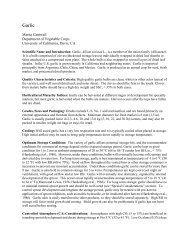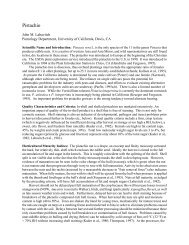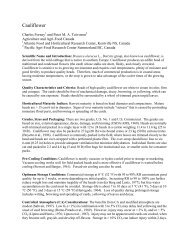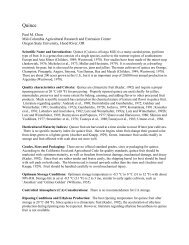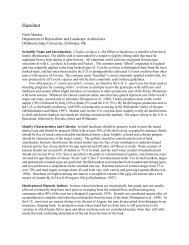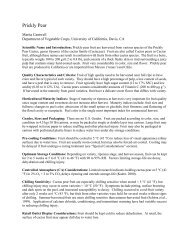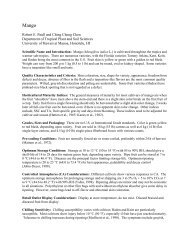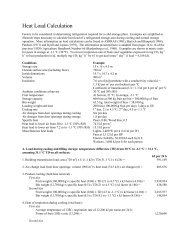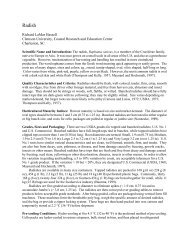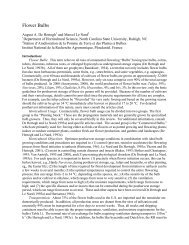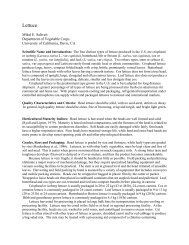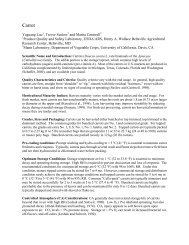Celery
Celery
Celery
- No tags were found...
Create successful ePaper yourself
Turn your PDF publications into a flip-book with our unique Google optimized e-Paper software.
Chilling Sensitivity: <strong>Celery</strong> is not chilling sensitive and should be stored as cold as possible withoutfreezing. The freezing point for celery is -0.5 °C (31.1 °F) (Whiteman, 1957).Ethylene Production and Sensitivity: <strong>Celery</strong> produces a small amount of ethylene (< 0.1 µL kg -1 h -1 at 20°C (68 °F). The effect of ethylene is temperature and concentration dependent. <strong>Celery</strong> is not very sensitiveto low concentrations of ethylene when exposure occurs at low temperatures. At temperatures above 5 °C(41 °F), but more practically 10 °C (50 °F), exposure to > 10 µL L -1 ethylene can result in an accelerated lossof green color and development of pithiness.Respiration Rates:Temperature mg CO 2 kg -1 h -10 °C 10 to 205 °C 13 to 2610 °C 20 to 4215 °C 26 to 5420 °C 46 to 95To get mL kg -1 h -1 , divide the mg kg -1 h -1 rate by 2.0 at 0 °C (32 °F), 1.9 at 10 °C (50 °F), and 1.8 at 20 °C(68 °F). To calculate heat production, multiply mg kg -1 h -1 by 220 to get BTU per ton per day or by 61 toget kcal per metric ton per day. Data are from Hardenburg et al. (1986).Physiological Disorders: Pithiness is a major source of quality loss and decreased shelf-life in celery(Saltveit and Mangrich, 1996). It is characterized by the appearance of whitish regions and air spaceswithin the tissues and reduced tissue density, and is caused by the breakdown of the internal pithparenchyma tissues of the petiole to produce aerenchyma. Pithiness may be induced by pre-harvest factors,including cold stress, water stress, pre-bolting (seed stalk induction), and root infection. Storagetemperature has a major impact on development of pithiness after pre-harvest induction. Progressivedevelopment of pithiness is delayed by storage at 0 °C (32 °F).Blackheart is a physiological disorder caused by cell death resulting from calcium deficiency, andpre-harvest water stress. Internal leaves develop brown discoloration, which eventually becomes deepblack.Brown check is a disorder related to boron deficiency. It appears as cracks on the inner petiole surfaceand is also refereed to as crack stem. The exposed tissues become brown and are susceptible to pathogeninfection and decay.Crushing or cracking are signs of mechanical damage, and may lead to rapid browning and decay.Harvesting, packing and handling should be done with great care to prevent damage to the highly sensitiveturgid petioles.Freezing injury starts at temperatures below -0.5 °C (31.1 °F). Mild freezing causes depressions in thetissues that subsequently turn brown. Severely frozen tissues develop wilted and water soaked appearanceon thawing.Postharvest Pathology: The most prominent storage decay is bacteria soft rot (primarily caused byPectobacterium or Pseudomonas), gray mold (Botrytis cinerea), and watery soft rot (Sclerotinia spp.)(Snowden, 1992). Keeping storage temperature near 0 °C (32 °F) is important to minimize losses due topostharvest decay. Controlled atmospheres (1.5% O 2 + 7.5% CO 2 ) have been shown to suppress the growthof Sclerotinia and watery soft rot (Reys and Smith, 1986; Reys and Smith, 1987). However, carefulmaintenance of atmospheric composition is required as celery is sensitive to low O 2 and high CO 2 injury.Quarantine Issues: None. However, export loads of celery may be fumigated at entry ports if commoninsects (aphids, thrips) are found.
Suitability as Fresh-cut Product: The majority of fresh-cut celery is in the form of celery sticks (cutpetioles). Fresh-cut celery can be packed alone or in combination with other vegetables, such as carrots andbroccoli. The shelf-life of fresh-cut celery is typically 12 to 14 days at 0 to 5 °C (32 to 41 °F). Discolorationof vascular tissue, splitting of the cut ends, and bacteria decay are major problems limiting shelf-life offresh-cut celery (Robbs et al., 1996; Saltveit and Mangrich, 1996).References:Gariepy, Y., G.S.V. Raghavan, R. Plasse, R. Theriault and C.T. Phan. 1984. Long-term storage of cabbage,celery, and leeks under controlled atmosphere. Acta Hort. 157:193-201.Hardenburg, R.E., A.E. Watada and C.Y. Wang. 1986. The Commercial Storage of Fruits, Vegetables, andFlorist and Nursery Stocks. USDA Agric. Hdbk No. 66, Washington, D.C.Leshuk, J.A. and M.E. Saltveit. 1990. Controlled atmosphere storage requirements and recommendationsfor vegetables. In: M. Calderon and R. Barkai-Golan (eds) Food Preservation by ModifiedAtmospheres. CRC Press, Boca Raton FL, pp. 315-352.Peirce, L.C. 1987. Vegetables - Characteristics, Production, and Marketing. John Wiley and Sons, pp.240-245.Reys, A.A., and R.B. Smith. 1986. Suppression of sclerotinia and watery soft rot of celery by controlledatmosphere storage. Plant Dis. 72:790-792.Reyes, A.A., and Smith, R.B. 1987. Effect of oxygen, carbon dioxide, and carbon monoxide on celery instorage. HortScience 22:270-271.Robbs, P.G., J.A. Bartz, G. McFie and N.C. Hodge. 1996. Causes of decay of fresh-cut celery. J. Food Sci.61:444-448.Saltveit, M.E. 1997. A summary of CA and MA requirements and recommendations for harvestedvegetables. In: 7 th Intl. Contr. Atmos. Res. Conf., Vol. 4, Vegetables and Ornamentals. Univ. Calif.,Davis CA, Postharv. Hort. Ser. 18:98-117.Saltveit, M.E. and M.E. Mangrich. 1996. Using density measurement to study the effect of excision,storage, abscisic acid, and ethylene on pithiness in celery petioles. J. Amer. Soc. Hort. Sci.121:137-141.Shaffer, E. (ed) 2000. Produce Availability and Merchandising Guide. The Packer, Vance Publishing Corp.,Lenexa, KS.Snowdon, A.L. 1992. Color atlas of postharvest diseases and disorders of fruits and vegetables. Vol. 2. CRCPress, Boca Raton FL, pp. 182-195.Suslow, T. and M. Cantwell. 1998. <strong>Celery</strong> Produce Facts. Recommendations for Maintaining PostharvestQuality. http://postharvest.ucdavis.edu/produce.Whiteman, T. 1957. Freezing points of fruits, vegetables and florists stocks. USDA Mkt. Res. Rpt. 32, p.196.



